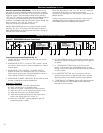
Receiver Controls and Functions (Continued)
Saving to a different user PRESET# location
To store settings to a different user preset location, hold the
Mode/Set button. The receiver shows “STORE XXXXXX”
(where XXXXXX indicates the loaded preset’s name).
Touch the Up/Down buttons to scroll to another preset location
(the display shows the user-defined name for each location, or
“PRESET#” if no name has been assigned).
At the desired preset location,
hold the Mode/Set button. The
first character of the name becomes the cursor and flashes.
Touch the Up/Down arrow buttons to scroll through the
characters until the desir
ed character is displayed.
T
ouch
the
Mode/Set button to accept the character and advance to
the next character. To advance the cursor without changing the
character,
touch the Mode/Set button.
After setting the last character,
hold the Mode/Set button to
store the name and revert to normal operation.
Holding the
Mode/Set button at any time during the naming process while
the cursor is flashing will store the setting and return the
receiver to normal operation.
Note: To escape the naming process,
touch the Mode/Set
button repeatedly until the last character is flashing, and then
touch the Mode/Set button again to escape. At the flashing
“ESCAPE” display,
touch the Mode/Set button to go back to
the beginning of the name, or
hold the Mode/Set button to
return to “QUIT.”
Receiver Functions
IntelliScan
™
Channel Assignment System
The IntelliScan
™
channel assignment system, provided on both
the AEW-R4100 and AEW-R5200 receivers, eliminates the
trouble and frustration normally encountered while attempting
to find and select usable, compatible frequencies in a multi-
channel system. The Artist Elite receivers are simply connected
together with included communication link cables. A “Master”
receiver then “knows” how many total channels it is looking
for
. It can scan the available fr
equencies, checking for local
interference sources, selecting a group of channels that will
all work together (using a built-in frequency plan), and automati-
cally setting the other linked AEW r
eceivers accor
dingly
. Once
this procedure is completed, the transmitter frequencies must
be set to match the receiver frequencies.
Receiver Locks
Programmable locks restrict the ability to change receiver
settings, reducing the possibility of unauthorized access or unin-
tended changes during performances.
Setting
Description
NO.LOC Receiver functions and frequency settings
can be edited fr
om the receiver’s front panel
or fr
om an associated computer via an
Ether
net connection to a linked AEW-R5200.
ALL.LOC Receiver functions and fr
equency settings
cannot be edited from the front panel or
from a computer via an Ethernet connection
to a linked AEW-R5200.
ALL.LOC must be
changed via the receiver’s Menu before other
settings can be changed.
PC.LOC Receiver functions and frequency settings
can be edited from the receiver’s front panel,
but they
cannot be edited from an
associated computer (via an Ethernet
connection to a linked AEW-R5200).
RX.LOC Receiver functions and frequency settings
can be edited from an associated computer
(via an Ethernet connection to a linked
AEW-R5200), but they
cannot be edited
from the receiver’s front panel.
When
any lock condition is applied to a receiver (ALL., RX. or
PC.), the LCD window displays a small “RX LOCK” just to the
right of the frequency. If an action is attempted that currently is
locked out, the LCD will briefly display “
LOCKED”, then return
to its previously displayed contents.
Note: Locks remain in place even when receiver power is
turned off. However, locks may be removed by using the Menu.
Antenna Power
This function turns on the 12V AC antenna power for use with
powered antennas or accessories.
Digital Tone Lock
™
Squelch
The Artist Elite Series employs a unique digital Tone Lock
squelch system that provides enhanced rejection of interfer-
ence. In addition to providing highly effective control of
unwanted noise, the T
one Lock signal fr
om the transmitter
also conveys data with the transmitter’
s name (Tx Name),
battery condition, mute status and lock status back to the
r
eceiver for display
. In addition to displaying in the r
eceiver’
s
LCD window, the data are also displayed on an Ethernet-
connected computer.
The squelch level is adjustable in fifteen 2 dB steps, providing
a 30 dB range. Increasing the squelch level – also called
“tightening the squelch” – can cause a reduction in usable
range of the wir
eless transmitter
, so use the lowest value that
r
eliably mutes the unwanted RF signals. (If interference is a
problem, first consider trying a different frequency, either
manually or by scanning.)
15
Note: While the receiver is in Edit mode, no action
(no buttons pressed) for approximately 30 seconds causes
the receiver to revert to Menu mode.
While the receiver is in Menu mode, no action for
approximately 30 seconds causes the receiver to revert
to normal operating mode. Any setting changes stored will
remain in the “NAME?” memory location, and the receiver
will display “NAME?” because the settings were not saved
to a user preset. This will occur even if a user preset was
previously loaded.


















